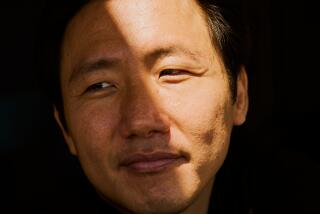A little espionage before bedtime
Graham GREENE divided his novels into serious works and “entertainments.”
They might just as easily have been categorized as stories about Catholicism and espionage, topics that actually were near neighbors in Greene’s labyrinthine but fertile inner geography.
Both categories will come to mind reading “The Spy’s Bedside Book,” a charming curiosity from 1957 now happily reissued by Random House’s Bantam imprint. Bedside miscellanies once were a mainstay of English publishing. There were popular collections of excerpts and quotations published for fox hunters, anglers, cricket aficionados and bird-watchers -- to recall just a few. “The Spy’s Bedside Book” was shrewder, more pointed sort of work, deftly selected and edited by Greene and his brother Hugh, who probably was best known as director general of the BBC. Graham Greene, of course, had been actively employed by Britain’s foreign intelligence agency, MI6, and may have enjoyed an on-again-off-again relationship with the security services for much of his life. Hugh -- a correspondent in prewar Berlin -- served in the RAF during World War II as an interrogator of captured German airmen.
What they produced in this curious miscellany was a volume that serves not simply as a companion to espionage fiction, but as a kind of spy’s how-to, right down to tips on secreting messages in boiled eggs and how to disguise maps in diagrams of butterfly wings (thanks to Sir Robert Baden-Powell, who actually did that). Other writers and secret agents represented include John Buchan, W. Somerset Maugham, Joseph Conrad, William Le Queux, James Fenimore Cooper, Rudyard Kipling, W.H. Auden, Eric Ambler and Benedict Arnold’s confrere, the luckless Major Andre. (Erskine Childers, the author of the 20th century’s first and still classic spy novel, “The Riddle of the Sands,” is curiously absent.)
This original volume came with a preface by Graham Greene and an afterward by Hugh. Both are included here, along with a new introduction by Dame Stella Rimington, former head of MI5, Britain’s counterintelligence service. She artfully ranges across the history of espionage fiction -- she doesn’t omit Childers -- and usefully distinguishes between novels of detection and spy stories. Rimington rightly places Greene’s own books in the “realist” tradition of espionage fiction, alongside Conrad and John le Carre.
“Greene, the spy writer, has his dark and sad moments, revealed in ‘The Third Man’ and ‘The Human Factor,’ a tale which compounds treachery and error to conclude with the defection of a double-agent to Moscow -- possibly a reference to [Kim] Philby, Greene’s wartime boss in MI6,” she muses. “But he never reaches to the pessimism and calculated confusion of le Carre, nor to the detached awfulness of Conrad’s Verloc. . . .”
Greene’s own introduction begins in a rush of those endless, inimitably elegant sentences. The authorial tongue is firmly planted in cheek, though halfway through the chuckle, the reader may suddenly realize that it’s far from clear at whose expense the joke proceeds. Greene writes:
“I am scarcely qualified to write this preface, for I doubt whether I have known more than a dozen spies in my life, and I am still uncertain about two of them -- a certain Swiss businessman whose notebook I borrowed for a few hours many years ago (strangely it contained the address of a friend of mine two thousands miles away who died a year later in a Nazi concentration camp), and another man of rather indeterminate origin with whom I planned to spend a Christmas holiday in the Banana Islands in the company of two African blind dates. . . . Of one spy, however, I have reason to be certain: he had hardly the qualifications of the others, for he was illiterate, he couldn’t count above 10, and the only point of the compass he knew was the East, because he was a Mohammedan. I was reminded of him in recent years by the report of a divorce case in which the judge expressed severe criticisms of a private detective. The detective was also illiterate, he rode to his work on a bicycle and dictated his reports to his landlady who was stone deaf. Life is strange.”
The plots of at least three engrossing novels are embedded in that paragraph -- or, perhaps, the outline of a single illusive, and magnificently allusive, tale over which hovers the perpetual question about all spies and their stories: Which part, if any, is true? Somehow, as entertaining as this delightfully erudite miscellany may be, it makes you wish that what you had at hand was a collection of excerpts from Greene’s own works.
For, as Rimington correctly points out, Greene’s espionage novels stand firmly in the “realist school”; so, too, do his Catholic fictions -- and, to an extent seldom recognized, the experience of imagining the one deeply informed his conception of the other. Greene understood that the spy’s art is an aesthetic of betrayal. His Catholicism was preoccupied with sin -- not so much as an engine of guilt, but as a manifestation of man’s fallen nature and, in some mysterious sense, as the ground of human solidarity.
It’s interesting that one of the few writers to take note of this was the late Swiss Jesuit Hans Urs von Balthasar, favorite theologian of the last two popes. (The range of Von Balthasar’s intellect was legendary and his aristocratic French colleague Henri de Lubac once referred to him as “the most cultured man in Europe.” Late in life, Von Balthasar gave away his recorded collection of Mozart’s complete works because he had committed it to memory.) In his classic “The Christian and Anxiety,” Von Balthasar called Greene “a great writer,” but accused him of promulgating a “mystique of sin”: “The thesis set forth under the pretext of sincerity and anti-pharisaism, that guilt itself, when assumed voluntarily (in solidarity with another sinner), contains a redemptive element, which is today perhaps the decisive element; this plainly and necessarily contradicts true redemption.”
Greene’s art, in fact, was situated in the other great current of 20th century Catholic thought that originated with another of Ignatius Loyola’s German-speaking sons, Karl Rahner, who argued that, “Apart from wholly universal norms of an abstract kind, and apart from a radical orientation of human life towards God as the outcome of a supernatural and grace-given self-commitment, there are hardly any particular or individual norms of Christian morality which could be proclaimed . . . unequivocally . . . to have the force of dogmas.” Rahner would conclude that “the only mortal sin is the will to die autonomously” -- that is, to be willfully alienated from other human beings.
Something like that was at work when Greene, the spy, quit MI6 rather than participate in unmasking his friend, the traitorous Philby. As Greene’s biographer, Norman Sherry, writes, “Perhaps Greene, always intuitive, resigned because he suspected that Philby was a Russian penetration agent. . . If Greene did suspect Philby, it would be just the kind of thing that would catapult him out of the service rather than share his suspicions with the authorities.”
Apart from the sheer capaciousness of the editors’ erudition and minds, part of what makes “The Spy’s Bedside Book” such engaging reading is what Greene calls his effort to evoke his fellow spies as “absurd and improbable” figures. Something deeper than empathy, though, infuses the spirit of this volume. That’s because, ultimately, Greene, the Catholic and secret agent, reached a conclusion very like that of the Jesuit Rahner: “In human relationships, kindness and lies are worth a thousand truths.”
--
More to Read
Sign up for our Book Club newsletter
Get the latest news, events and more from the Los Angeles Times Book Club, and help us get L.A. reading and talking.
You may occasionally receive promotional content from the Los Angeles Times.










